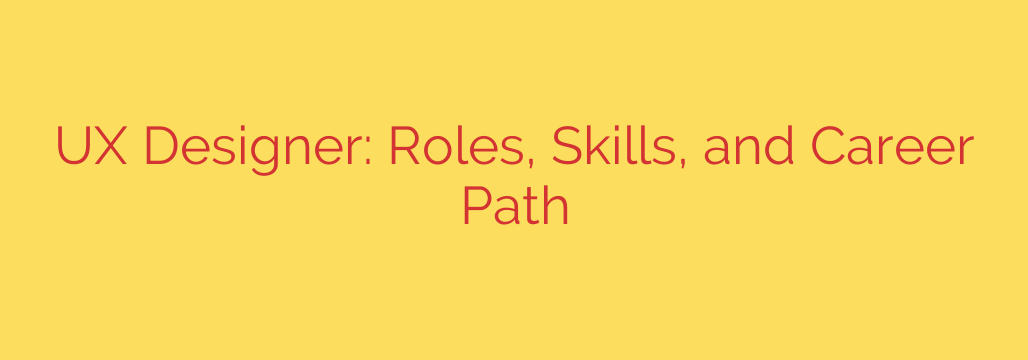
What is a UX Designer? A Complete Guide to Roles, Skills, and Career Paths
In our increasingly digital world, you’ve likely used an app that felt confusing or a website that was impossible to navigate. You’ve also probably used a service that was so intuitive and seamless it felt effortless. The difference between these two experiences is often the work of a User Experience (UX) designer.
A UX designer is, at their core, an advocate for the user. Their primary goal is to make technology, whether it’s a website, a mobile app, or a piece of software, easy, efficient, and enjoyable to use. They bridge the gap between human psychology and digital technology, ensuring that products are not just functional, but also meaningful and accessible to the people they are designed for.
The Core Responsibilities of a UX Designer
The role of a UX designer is multifaceted and involves a deep understanding of user needs and business goals. While daily tasks can vary, they typically revolve around a structured design process.
Conducting User Research: This is the foundation of all UX work. Designers use methods like interviews, surveys, and observation to understand user behaviors, pain points, and motivations. Without solid research, design is just guesswork.
Creating User Personas and Journey Maps: Based on research, designers create fictional user profiles called “personas” to represent key audience segments. They then map out “user journeys” to visualize the steps a person takes to accomplish a goal with the product, identifying opportunities for improvement along the way.
Information Architecture (IA): This involves organizing and structuring content in a logical and intuitive way. A strong IA ensures users can easily find the information they need without feeling lost or overwhelmed. Think of it as the blueprint for a website’s navigation.
Wireframing and Prototyping: Designers create wireframes—basic, low-fidelity layouts—to map out the structure and functionality of a page. These evolve into high-fidelity, interactive prototypes that look and feel like the final product, allowing for testing before any code is written.
Usability Testing: This is a critical step where real users are asked to perform tasks with a prototype. Designers observe their interactions to identify usability issues and areas of confusion. The feedback gathered here is used to refine and improve the design.
Collaboration: UX designers do not work in isolation. They collaborate closely with User Interface (UI) designers, product managers, developers, and stakeholders to ensure the final product is feasible, viable, and meets user needs.
UX vs. UI: Understanding the Critical Difference
The terms UX and UI are often used interchangeably, but they represent two distinct disciplines.
Think of building a house. The UX designer is the architect who plans the layout, ensures the flow between rooms makes sense, and considers how the inhabitants will live in the space. They focus on the foundation, the structure, and the overall functionality.
The UI (User Interface) designer is the interior designer. They choose the color palette, select the furniture, and arrange the decor. They focus on the visual and aesthetic elements that people interact with directly—the buttons, typography, and icons.
In short, UX design is about the overall feel and experience, while UI design is about the look and interactivity. A product needs both to succeed.
Essential Skills for a Successful UX Designer
To excel in this field, a designer needs a balanced mix of technical (hard) and interpersonal (soft) skills.
Technical & Hard Skills
- User Research and Analysis: The ability to plan, conduct, and synthesize research to generate actionable insights.
- Wireframing and Prototyping: Proficiency with industry-standard tools like Figma, Sketch, and Adobe XD to create everything from simple sketches to interactive mockups.
- Information Architecture: A strong understanding of how to organize complex information in a clear and logical manner.
- Usability Testing: Knowing how to design and run tests, gather feedback, and iterate on designs based on the results.
Crucial Soft Skills
- Empathy: This is arguably the most important skill for a UX designer. You must be able to step into the user’s shoes and understand their needs, goals, and frustrations from their perspective.
- Communication: Clearly articulating design decisions and research findings to team members and stakeholders is essential for getting buy-in and ensuring everyone is aligned.
- Collaboration: The ability to work effectively in a team environment, accepting feedback and integrating ideas from developers, product managers, and other designers.
- Problem-Solving: At its heart, UX design is about solving problems for users. A successful designer is a critical thinker who is endlessly curious about finding better solutions.
The Typical UX Designer Career Path
The career ladder in UX offers significant room for growth and specialization.
- Junior UX Designer: An entry-level role focused on learning and supporting a team. Juniors often work on smaller features, conduct research, and create wireframes under the guidance of senior designers.
- Mid-Level UX Designer: With a few years of experience, a designer gains more autonomy and may own projects from start to finish. They have a solid grasp of the design process and contribute to strategic decisions.
- Senior UX Designer: A senior designer leads complex, high-impact projects. They are responsible for the end-to-end design process, mentoring junior designers, and influencing product strategy.
- Lead/Principal Designer or UX Manager: At this stage, the path can split. A Lead or Principal Designer becomes a top-level individual contributor, tackling the most challenging design problems and setting the standard for quality. A UX Manager moves into a leadership role, focusing on managing a team of designers, hiring, and shaping the overall design culture of the organization.
How to Start Your Career in UX Design
Breaking into the field of UX design is more accessible than ever. Here are some actionable steps you can take:
- Build Your Knowledge: Immerse yourself in the fundamentals. There are countless online courses (from platforms like Coursera and Interaction Design Foundation), intensive bootcamps, and articles from trusted sources like the Nielsen Norman Group.
- Master the Tools: Gain proficiency in core design software. Figma has become the industry standard, so it’s an excellent place to start.
- Create a Strong Portfolio: This is the most critical element for landing a job. Your portfolio is your most important career asset. Don’t just show finished designs; create 2-3 detailed case studies that walk through your entire process. Explain the problem, show your research, display your wireframes and prototypes, and share the final outcome.
- Gain Practical Experience: You don’t need a job to get experience. Offer to help a local non-profit redesign their website, work on a personal passion project, or participate in a design challenge to build out your portfolio.
Source: https://www.simplilearn.com/what-does-ux-designer-do-article








